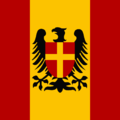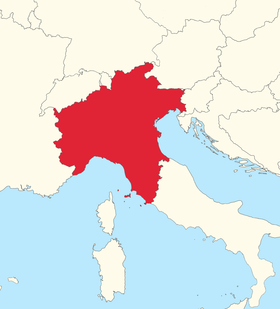Template:Front/featured: Difference between revisions
Chrysophylax (talk | contribs) m (fix so you can actually click the damn linekw) |
Chrysophylax (talk | contribs) No edit summary |
||
| Line 1: | Line 1: | ||
{{Infobox language | {{Infobox language | ||
|image= | |image = Flag of Avendonia square 2.png | ||
|imagesize= | |imagesize = 120px | ||
|name= | |name = Avendonian | ||
|nativename= | |nativename = avendoniano | ||
|pronunciation= | |pronunciation = avendoˈni̯ano | ||
| | |pronunciation_key = IPA for Avendonian | ||
| | |state = Avendonia | ||
|setting= | |setting = Alt-history Europe, Northern Italic Peninsula | ||
|created = 2009 | |||
|familycolor = Indo-European | |||
|fam2 = [[w:Germanic languages|Germanic]] | |||
|fam3 = [[w:West Germanic languages|West Germanic]] | |||
|familycolor=Indo-European | |fam4 = ''{{Abbtip|partially|part.}}'' [[w:Elbe Germanic|Elbe Germanic]] | ||
| | |ancestor = Pre-Avendonian | ||
| | |creator = S.C. | ||
| | |dia1 = North Adriatic (''nordadriatico'') | ||
| | |dia2 = Alpine (''alpino'') | ||
| | |dia3 = High Burgundian (''ocburgundico'') | ||
| | |dia4 = Low Burgundian (''lagburgundico'') | ||
| | |dia5 = Genoese (''genoico'') | ||
|notice=IPA | |stand1 = Central Avendonian dialect | ||
|script1 = Latn | |||
|nation = Avendonia | |||
|agency = Grunditio Cuningica per la Spraca Avendoniana | |||
|map = Locator Map Avendonia.png | |||
|mapsize = 280px | |||
|mapcaption = Approximate borders of Avendonia | |||
|notice = IPA | |||
}} | }} | ||
[[Avendonian]] ([[w:endonym|autoglossonym]]: ''avendoniano''; <small>Avendonian: </small><span title="Representation in the International Phonetic Alphabet (IPA)" style="font-family:Gentium,'DejaVu Sans','Segoe UI',sans-serif">[[IPA for Avendonian|[avendoˈni̯ano]]]</span>) is a [[w:West Germanic language|West Germanic language]], with strong influence of [[w:Vulgar Latin|Vulgar Latin]]. It is the result of a prolonged contact among members of both regions, after West Germanic merchants began travelling to and from the [[w:Western Roman Empire|Western Roman Empire]]. These connections—and the conquest by the Germanic tribes of the northern skirts of the Roman Empire—slowly formed a [[w:creole language|creole]] for mutual communication. Eventually, permanent settlements were established in what would become modern-day Avendonia, where Avendonian is primarily spoken, with official status. | |||
While its vocabulary derives for the most part from [[w:Proto-Germanic|Proto-Germanic]], Latin influence is most notable in its phonology and its grammar. | |||
Avendonian grammar is relatively straightforward and akin to the grammar of other Romance languages, due to the influence of Latin. | |||
# Two sets of articles, indefinite and definite, preceding the noun. | |||
# Gender and number inflection in nouns, adjectives, and pronouns. Articles and adjectives must agree inflection-wise with the noun or pronoun they modify. | |||
# Twofold gender system, masculine and feminine. Loss of Latin neuter gender. | |||
# Fusional verb inflection for person, number, mood, and tense. | |||
However, noun and adjective declension endings, along with the ablaut in strong verbs are elements derived from Germanic. | |||
Nouns in Avendonian fall in one of the following almost fully regular declensions: | |||
* '''A-stem''': mostly feminine nouns. From [[w:Latin declension#First declension (a stems)|Latin first declension]] and [[w:Proto-Germanic grammar#ō-stems|Germanic ō-]] and [[w:Proto-Germanic grammar#ōn-stems|ōn-stems]]. E.g. '''{{term|erda}}'''. | |||
* '''O-stem''': chiefly masculine nouns. From [[w:Latin declension#Second declension (o stems)|Latin second declension]] and [[w:Proto-Germanic grammar#a-stems|Germanic a-stems]]. E.g. '''{{term|vundro}}'''. | |||
* '''E-stem''': both genders. From the [[w:Latin declension#Third declension|third]] and [[w:Latin declension#Fifth declension (e stems)|fifth declensions of Latin]] and various Germanic stems (like [[w:Proto-Germanic grammar#an-stems|an-stems]]). E.g. '''{{term|snege}}'''. | |||
* '''U-stem''': both genders but mainly masculine. From Latin [[w:Latin declension#Fourth declension (u stems)|fourth declension]] and [[w:Proto-Germanic grammar#u-stems|u-stem]] from Germanic. E.g. '''{{term|vintro}}'''. | |||
Notable exceptions are the productive suffix '''{{term|-tio}}''', which forms feminine o-stem nouns from verbs, and the '''{{term|-ista}}''' suffix forms [[w:epicenity#Specialized uses|epicene]] a-stem nouns. Other words have no distinctive feature in the modern language, i.e. differences are etymological. | |||
There are six major dialects of Avendonian. Central Avendonian (or '''midio''') is considered the standard language, and it is the language most of the author's work is based upon. The main features of the other five dialects will be discussed in the following sections. | |||
<noinclude>[[Category:Templates]][[Category:Main page]][[Category:Meta]]</noinclude> | <noinclude>[[Category:Templates]][[Category:Main page]][[Category:Meta]]</noinclude> | ||
Revision as of 09:22, 19 July 2021
| Avendonian | |
|---|---|
| avendoniano | |
 | |
| Pronunciation | [avendoˈni̯ano] |
| Created by | S.C. |
| Date | 2009 |
| Setting | Alt-history Europe, Northern Italic Peninsula |
| Native to | Avendonia |
Indo-European
| |
Early form | Pre-Avendonian
|
Standard form | Central Avendonian dialect
|
Dialects |
|
| Official status | |
Official language in | Avendonia |
| Regulated by | Grunditio Cuningica per la Spraca Avendoniana |
Approximate borders of Avendonia | |
Avendonian (autoglossonym: avendoniano; Avendonian: [avendoˈni̯ano]) is a West Germanic language, with strong influence of Vulgar Latin. It is the result of a prolonged contact among members of both regions, after West Germanic merchants began travelling to and from the Western Roman Empire. These connections—and the conquest by the Germanic tribes of the northern skirts of the Roman Empire—slowly formed a creole for mutual communication. Eventually, permanent settlements were established in what would become modern-day Avendonia, where Avendonian is primarily spoken, with official status.
While its vocabulary derives for the most part from Proto-Germanic, Latin influence is most notable in its phonology and its grammar.
Avendonian grammar is relatively straightforward and akin to the grammar of other Romance languages, due to the influence of Latin.
- Two sets of articles, indefinite and definite, preceding the noun.
- Gender and number inflection in nouns, adjectives, and pronouns. Articles and adjectives must agree inflection-wise with the noun or pronoun they modify.
- Twofold gender system, masculine and feminine. Loss of Latin neuter gender.
- Fusional verb inflection for person, number, mood, and tense.
However, noun and adjective declension endings, along with the ablaut in strong verbs are elements derived from Germanic.
Nouns in Avendonian fall in one of the following almost fully regular declensions:
- A-stem: mostly feminine nouns. From Latin first declension and Germanic ō- and ōn-stems. E.g. erda.
- O-stem: chiefly masculine nouns. From Latin second declension and Germanic a-stems. E.g. vundro.
- E-stem: both genders. From the third and fifth declensions of Latin and various Germanic stems (like an-stems). E.g. snege.
- U-stem: both genders but mainly masculine. From Latin fourth declension and u-stem from Germanic. E.g. vintro.
Notable exceptions are the productive suffix -tio, which forms feminine o-stem nouns from verbs, and the -ista suffix forms epicene a-stem nouns. Other words have no distinctive feature in the modern language, i.e. differences are etymological.
There are six major dialects of Avendonian. Central Avendonian (or midio) is considered the standard language, and it is the language most of the author's work is based upon. The main features of the other five dialects will be discussed in the following sections.
